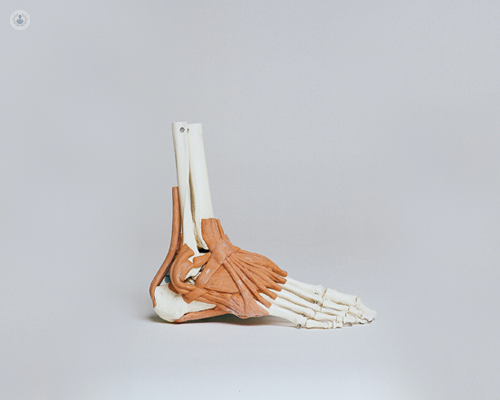How do you know if you have arthritis in your ankles?
Written by:Ankle arthritis has various symptoms, but what are they?
Here to provide a detailed take on the signs of this debilitating condition is leading consultant orthopaedic foot and ankle surgeon Mr Togay Koç.

Arthritis in the ankle can cause a range of symptoms, including:
- Pain or tenderness in the ankle joint, which may be worse during or after physical activity.
- Stiffness in the ankle joint, especially in the morning or after sitting for a long time.
- Swelling or inflammation around the ankle joint.
- Limited range of motion, making it difficult to move the ankle joint.
- A cracking or clunking sound when moving the ankle joint.
If you experience any of these symptoms, it is essential to consult with a doctor to determine the cause and appropriate treatment. The doctor may conduct a physical examination and order imaging tests such as an X-ray, CT or MRI to confirm a diagnosis of arthritis in the ankle joint.
What triggers arthritis in the ankle?
There are various factors that can trigger arthritis in the ankle, including:
- Age: As a person ages, the risk of developing arthritis increases due to wear and tear on the joints over time.
- Genetics: Certain genetic factors can increase the likelihood of developing arthritis.
- Foot arch shape: A high arched or flat foot can increase the chances of developing ankle arthritis.
- Injury: Previous injuries, such as a sprain or fracture, can damage the cartilage and joint, leading to the development of arthritis later on.
- Repetitive stress: Activities or occupations that involve repetitive stress on the ankle joint, such as running or standing for long periods, can increase the risk of developing arthritis.
- Infection: In rare cases, infections can cause arthritis in the ankle joint.
- Other medical conditions: Certain medical conditions such as gout or rheumatoid arthritis can increase the risk of developing arthritis in the ankle joint.
It is essential to speak with a doctor if you are experiencing symptoms of arthritis in the ankle or if you have any concerns about your ankle joint health.
Is walking good for ankle arthritis?
Low-impact exercise such as walking can be beneficial for people with ankle arthritis, as it can improve ankle mobility and reduce stiffness caused by arthritis. Walking can also help to maintain a healthy weight, which can reduce pressure on the ankle joint and reduce arthritis symptoms.
However, high-impact exercise such as those that involve running or jumping, can exacerbate the symptoms of ankle arthritis.
It is important to consult with a doctor or physical therapist before starting any exercise program to ensure that it is safe and appropriate for the individual. Depending on the severity of the arthritis, certain modifications or adjustments may be necessary to prevent further damage or discomfort.
In some cases, other low-impact exercises such as swimming, cycling, or yoga may be recommended as an alternative to walking. A healthcare professional can recommend specific exercises based on the individual's symptoms, mobility level, and overall health.
What exercises can help relieve arthritis pain?
There are several exercises that can help relieve ankle arthritis pain and improve mobility in the ankle joint. However, it’s important to consult with a doctor or physical therapist before starting any exercise program to ensure that it is safe and appropriate for the individual.
Here are some exercises that may be helpful:
Range of motion exercises
These exercises can help improve flexibility and reduce stiffness in the ankle joint. Examples include ankle circles, ankle pumps, and ankle alphabet exercises.
Strengthening exercises
Strengthening exercises can help improve the strength of the muscles surrounding the ankle joint, which can help support and stabilise the joint. Examples include heel raises, toe curls, and ankle resistance exercises using a resistance band.
Aerobic exercises
Low-impact aerobic exercises such as walking, cycling, or swimming can help improve cardiovascular health, reduce weight, which can reduce pressure on the ankle joint therefore reducing arthritis pain.
Balance exercises
These exercises can help improve balance and stability, which can reduce the risk of falls and further injury to the ankle joint. Examples include standing on one foot, heel-to-toe walking, and balance board exercises.
Stretching exercises
Stretching can help improve flexibility and reduce muscle tension around the ankle joint. Examples include:
- calf stretches;
- hamstring stretches, and;
- quad stretches.
It’s important to start slowly and gradually increase the intensity and duration of exercise as tolerated. If any pain or discomfort is experienced during exercise, it’s essential to stop and speak with a doctor or physical therapist before continuing.
How do you treat arthritis in the ankle?
There are several treatments available for arthritis in the ankle, including both non-surgical and surgical options. The appropriate treatment plan will depend on the severity of the arthritis, the individual's symptoms, and their overall health.
Non-surgical treatments for arthritis in the ankle may include:
- Pain management with over-the-counter or prescription medication, such as paracetamol, nonsteroidal anti-inflammatory drugs (NSAIDs), such as ibuprofen or corticosteroids.
- Physical therapy to improve mobility, strength, and flexibility in the ankle joint.
- Bracing or using orthotics, such as insoles, to support the ankle joint, improve foot and ankle alignment and reduce pain.
- Using assistive devices such as crutches or a cane to reduce stress on the ankle joint.
- Weight loss or maintaining a healthy weight to reduce pressure on the ankle joint.
- Low-impact exercise such as walking, swimming, or cycling to improve mobility and reduce stiffness.
- Surgical treatments for arthritis in the ankle may include:
- Arthroscopy, a minimally invasive procedure that uses small incisions and a camera to remove debris or repair damaged cartilage in the ankle joint.
- Osteotomies - Cutting, realigning and fixating a bone, can be performed to improve the alignment of the foot and ankle to redistribute the pressure that goes through the ankle joint.
- Fusion surgery, which involves fusing the ankle joint bones together to reduce pain and improve stability.
- Joint replacement surgery, which involves replacing the damaged ankle joint with an artificial joint.
It’s important to speak with a doctor to determine the best treatment plan for your specific condition.
If you’re concerned about arthritis of the ankle and how it’s affecting your quality of life, arrange a consultation with Mr Koç via his Top Doctors profile for expert attention.


